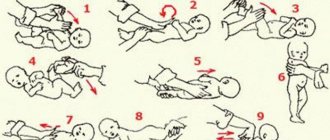Muscle tone in children: norm and pathology
Muscle tone in children: norm and pathology
Tone disorders occur in almost every baby in the first year of life. It is very important to identify the problem in time and help the child cope with it.
discuss in the cerebral palsy community
muscle tone, newborns (0-1 month), infants (1 month - 1 year), health, massage, physical therapy, cerebral palsy, cerebral palsy, cerebral palsy and other paralytic syndromes
Tone is the minimum muscle tension required to maintain the body position at rest. A baby who has lived in the fetal position for 9 months tends to have increased muscle tone after birth. However, the norm is considered to be such muscle tension when an adult can easily straighten the baby’s legs or unclench his fists. An important criterion is the symmetry of the tone and its predominance in the flexor muscles. With age, the tone gradually decreases.
To control muscle tone, it is necessary to regularly show the child to the doctor. The pediatrician checks the baby's reflexes and evaluates the condition of the baby's muscles.
The tone varies
Together with pediatric neurologist Knyazeva Inna Viktorovna, we will try to figure out what muscle tone is and what is considered normal. Even in sleep, our muscles do not relax completely and remain tense. This minimum tension, which remains in a state of relaxation and rest, is called muscle tone. The younger the child, the higher the tone - this is due to the fact that at first the surrounding space is limited to the uterus, and the child does not need to perform purposeful actions. In the fetal position (with the limbs and chin tightly pressed to the body), the muscles of the fetus are under strong tension, otherwise the child simply would not fit in the uterus. After birth (during the first six to eight months), muscle tone gradually weakens. Ideally, the muscle tone of a two-year-old baby should be approximately the same as that of an adult. But almost all modern babies have problems with tone. Poor ecology, complications during pregnancy, stress and a number of other unfavorable factors provoke impaired tone in newborns. There are several common muscle tone disorders.
Increased tone (hypertonicity).
The child seems tense and tense. Even in sleep, the baby does not relax: his legs are bent at the knees and pulled up to his stomach, his arms are crossed on his chest, and his fists are clenched (often in a “fig” shape). With hypertonicity, a child holds his head well from birth due to the strong tone of the occipital muscles (but this is not good).
Decreased tone (hypotonicity).
With decreased tone, the child is usually lethargic, moves his legs and arms little, and cannot hold his head up for a long time. Sometimes the child’s legs and arms extend at the knee and elbow joints by more than 180 degrees. If you place the baby on his stomach, he will not bend his arms under his chest, but spread them to the sides. The child looks limp and spread-eagled.
Asymmetry of muscle tone.
With asymmetry, the tone on one half of the body is higher than on the other. In this case, the child’s head and pelvis are turned towards the tense muscles, and the torso bends in an arc. When a child is placed on his stomach, he always falls to one side (where the tone is increased). In addition, asymmetry can be easily detected by the uneven distribution of the gluteal and thigh folds.
Uneven tone (dystonia).
Dystonia combines signs of hyper- and hypotonicity. In this case, the child’s muscles are too relaxed and others are too tense.
Self-control: normal muscle tone
Up to 1 month Lying on his back, the baby assumes the “fetal position”: arms are bent and pressed to the chest, fingers clenched into a fist, legs apart at the knees, skin folds are symmetrical. Lying on his stomach, the baby turns his head to the side, placing his arms under his chest. At the same time, he bends his legs and imitates crawling movements.
From 1 to 3 months, the baby can stretch his arms forward and bring them to his eyes or mouth. Closer to three months of age, he begins to reach for a toy - for play and development. If you put a rattle in his open palm, he holds it tightly. He lifts and holds his head well while lying on his stomach, turns his head in different directions.
From 3 to 6 months In the supine position, the baby’s arms and legs are half bent, palms open. The child purposefully reaches out to the toy and takes it. Closer to 4 months, the baby learns to roll over from his stomach to his back, and closer to 6 months - to sit up and crawl. By six months, the child rests on open palms, rising with outstretched arms.
From 6 to 9 months The child moves actively, rolls over from his stomach to his back and back. Sits down, crawls and makes the first attempts to stand up.
From 9 to 12 months, the baby crawls, stands up and tries to walk, first with support, and then independently.
Massage for increased and decreased tone in infants
It is best to start massage when the baby is two months old. But first, it is necessary to show the child to three specialists: a pediatrician, an orthopedist and a neurologist, who make a diagnosis and give recommendations. If a child requires drug treatment, it is usually “adjusted” to massage. A correctly and timely course of massage helps to correct many orthopedic disorders (clubfoot, incorrectly turned feet, etc.), normalize muscle tone and eliminate “residual” reflexes. In case of serious deviations from the norm, the massage should be performed by a professional. But you can slightly adjust the tone at home.
It is better to massage during the day, at least an hour after feeding. You should first ventilate the room and make sure that the temperature is not lower than 22 degrees; the child should not be hot or cold. Hands should be washed with warm water and wiped dry (so that they are warm). You should not cover your child’s entire body with massage oil or cream; just apply a small amount of cream to your hands. For massage, you can use special oil or regular baby cream. When giving a massage, talk gently to your child and watch his reaction. When the first signs of fatigue appear (crying, whining, dissatisfied grimaces), you should stop exercising.
During massage, all movements are made from the periphery to the center, starting from the limbs: from the hand to the shoulder, from the foot to the groin. In the first lessons, each exercise is repeated only once. At first, the entire massage complex will take no more than 5 minutes. Gradually increase the number of repetitions and time to 15-20 minutes.
To eliminate hypertonicity and residual reflexes, manifested in the child’s excessive activity, a so-called gentle massage
- it relaxes and calms. Start the massage by stroking your arms, legs, back with the back and palm surfaces of several closed fingers. You can alternate between flat (using the surface of your fingers) and grasping (with your whole hand) stroking. After stroking, the skin is rubbed in a circular motion. Place your baby on your stomach and place your palm along your baby's back. Without taking your hands off your baby's back, gently move his skin up, down, right and left in line movements, as if you were sifting sand through a sieve with your hand. Then place the child on his back, take his hand and shake it lightly, holding the child by the forearm. In this way, massage both arms and legs several times. Now you can move on to rocking. Grasp the baby's arm muscles (just above the wrist) and gently but quickly rock and shake his arms from side to side. Your movements should be fast and rhythmic, but not abrupt. Do the same with the legs, grabbing the child by the calf muscles. You need to finish the massage in the same way as you started - with smooth stroking.
In case of decreased tone, on the contrary, a stimulating massage
, which activates the child. Stimulating massage includes a large number of “chopping” movements. After traditional stroking with the edge of your palm, lightly walk along the baby's legs, arms and back. Then place your baby on his stomach and roll your knuckles over his back, bottom, legs and arms. Then turn your baby onto his back and roll your knuckles over his stomach, arms and legs.
physical therapy helps normalize muscle tone
, for example, exercises on a large inflatable ball. Place the child with his stomach on the ball, legs should be bent (like a frog) and pressed against the surface of the ball. Let dad, for example, hold the baby’s legs in this position, and you take the baby by the arms and pull him towards you. Then return the baby to the starting position. Now grab your baby's shins and pull them toward you until your baby's face is at the top of the ball or his feet touch the floor. Smoothly return the baby to its original position. Then tilt the child forward (away from you) so that his palms reach the floor (just make sure that the baby does not hit his forehead on the floor). Repeat this exercise several times forward and backward.
If you have asymmetrical tone, you should do a relaxing massage with force on the side in which the tone is lower. In addition, the following exercise on an inflatable ball has a good effect: place the child on the inflatable ball with the side in which it bends. Smoothly swing the ball along the axis of the child's body. Repeat this exercise 10-15 times daily.
Even if a child’s muscle tone is normal, this is not a reason to refuse preventive massage . Preventive massage includes both relaxing and activating movements. Massage techniques such as stroking (they begin and end the massage), rubbing, and kneading with stronger pressure are used. Use circular movements (clockwise) to massage your stomach to prevent colic and constipation. Use your thumb to stroke your baby's soles and lightly pat them. Then, with your entire palm, preferably both hands, stroke the baby’s chest from the middle to the sides, and then along the intercostal spaces. From three months onwards, it is useful to combine massage with gymnastics. The main goal of preventive massage is to prepare the child for walking. From two months to one year, a healthy child must undergo at least 4 massage courses (15-20 sessions each). When the child begins to walk, the intensity of the massage is reduced to twice a year. It is advisable to take massage courses in spring and autumn to improve the condition of the immune system, which is usually weakened at this time of year.
Hypertonicity
Increased muscle tone develops as a result of damage to the nervous system and brain. Causes: hypoxia during childbirth, birth injuries, cerebral hemorrhages, meningitis. Symptoms Hypertonicity is characterized by stiffness and tightness in the baby. The child does not relax even in his sleep, his legs are pressed to his body, and his hands are clenched into fists. Newborns may experience head retention that is not typical for this age. It occurs due to increased tone of the neck muscles. There are attacks of intestinal colic, anxiety and sleep disturbances; frequent regurgitation, trembling of the arms and chin may be characteristic.
Why is it dangerous? Reduces the speed of psychomotor development of the baby. Children with hypertonicity begin to sit up, crawl and walk later than their peers.
SYMPTOMS OF HYPERTONUS IN A CHILD
A mother can suspect hypertonicity in her baby in the very first month of his life, but only a doctor can determine what type he belongs to (physiological or pathological). But it is still very important to know a number of symptoms that may indicate hypertension in a child in order to bring them to the attention of the treating doctor. What does this include? • Increased anxiety; • Short sleep; • Constant screaming for no reason (yes, a child can and even should scream, but not most of the time he is awake); • A constant thirst for sucking (again, we can’t say that the baby shouldn’t want this, but if he asks for his mother’s breast every half hour, this can become an important symptom that is worth paying attention to), which can also be accompanied by poor appetite, rapid loss of interest in breasts; • Frequent regurgitation; • A child holding his head up to the age of 1 month, of course, can please mothers and even create the illusion that the child is strong and has already learned to fix his head, but you must definitely look at this situation from the point of view of the child’s physiology, then it will become clear that this is not a reason for pride, but a symptom of a problem, which should be reported to a specialist as soon as possible; • Bending the head back and bending the child’s body in the form of an arc; • If the child's head is always turned in the same direction or tilted towards the same shoulder; • If after 3 months the baby does not open his hands without resistance, presses them constantly to the body, bends them into fists and does not grab toys; • Constant stretching of the legs and arms, although for a child, as we have already learned above, it is typical, on the contrary, for them to bend; • Finally, when the child begins to slowly stand on his feet and rests not on the entire foot, but on its outer part or on the toe, which also should not cause an association with rhythmic gymnastics or dancing, but alert parents. If you find that your child has any of these symptoms, then you need to show your baby to the doctor. And if signs of increased tone persist after 6 months, then an examination by a pediatric neurologist is necessary.
Hypotonicity
Decreased muscle tone is less common than hypertonicity. The condition is typical for premature infants, children with endocrine and infectious diseases. Severe pronounced hypotonicity may indicate an intracranial hematoma or serious birth injuries.
Symptoms Children with hypotonia have prolonged sleep, a sedentary lifestyle, rare crying and whims. During sleep, the baby's arms and legs are extended along the body, and the stomach has a “spread out”, frog-like appearance. Such babies suck poorly and gain weight; they begin to hold their heads up late.
Why is it dangerous? With hypotonicity, the processes of sucking and swallowing may change. Possible breathing problems pose a serious threat to life.
Treatment of tone disorders
Complex therapy for tone disorders is prescribed by a pediatric neurologist. Typically, doctor's orders include:
- kinesitherapy (movement treatment, includes a course of massage and special gymnastics - active and passive);
- physiotherapy (magnetic therapy, electrophoresis, mud, water and heat treatment, etc. - prescribed in courses, usually alternating);
- drug treatment (in some cases, vitamins, drugs to reduce intracranial pressure, and drugs that improve metabolic processes are prescribed).
Timely diagnosed tone disorders respond well to complex treatment. After therapy, they disappear without a trace and no longer bother either the child or his parents.
Children with tone disorders need a massage from a competent specialist. Children's massage therapists determine the tone of each muscle and carry out the appropriate correction: relieve spasm or help increase tone. An unprofessional massage performed by a mother or grandmother can lead to a worsening of the child’s condition.
Author: Olesya Butuzova, pediatrician
The material used photographs belonging to shutterstock.com











